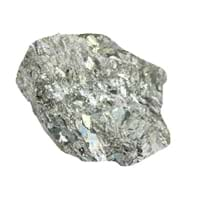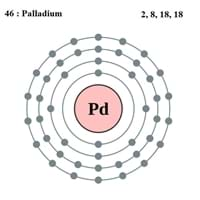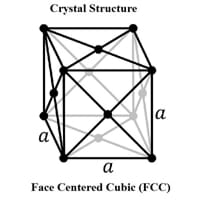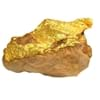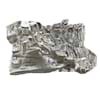Pd Element
Periodic Table
0
Symbol
Pd 0
Group Number
10 8
Period Number
5 3
Block
d block 0
Element Family
Transition Metal 0
CAS Number
7440053 74
Space Group Name
Fm_ 3m 0
Space Group Number
225.00 2
Facts
0
Interesting Facts
- Palladium alloys are used for Jewelry contains (95% Palladium and 5% Ruthenium)
- In the late 1800s, Palladium metal used have more economical value than the Platinum metal.
- Palladium element is known as a good catalyst
Sources
Ores of metals 0
History
0
Who Discovered
William Hyde Wollaston 0
Discovery
In 1803 0
Abundance
0
Abundance In Universe
2 * 10-7 % 22
Abundance In Sun
~0.0000003 % 24
Abundance In Meteorites
0.00 % 51
Abundance In Earth's Crust
0.00 % 48
Abundance In Oceans
Not Available 0
Abundance In Humans
Not Available 0
Uses
0
Uses & Benefits
- Mostly palladium metal is used in catalytic converters. In electronic industry it is used in ceramic capacitors of mobile and computer.
- It is used in jewellery and dental fillings and crowns.
Industrial Uses
Aerospace Industry, Automobile Industry, Electronic Industry 0
Medical Uses
Dentistry, Pharmaceutical Industry, Surgical Instruments Manufacturing 0
Other Uses
Coinage, Bullion, Jewellery 0
Biological Properties
0
Toxicity
Toxic 0
Present in Human Body
No 0
In Blood
Not Available 0
In Bone
Not Available 0
Physical
0
Melting Point
1,554.90 °C 22
Boiling Point
2,963.00 °C 33
Appearance
0
Physical State
Solid 0
Color
Silver 0
Luster
Metallic 0
Hardness
0
Mohs Hardness
4.75 9
Brinell Hardness
320.00 MPa 33
Vickers Hardness
121.00 MPa 36
Speed of Sound
3,070.00 m/s 26
Optical Properties
0
Refractive Index
1.72 1
Reflectivity
84.00 % 4
Allotropes
No 0
α Allotropes
Not Available 0
β Allotropes
Not Available 0
γ Allotropes
Not Available 0
Chemical
0
Chemical Formula
Pd 0
Isotopes
0
Known Isotopes
38 1
Electronegativity
0
Pauling Electronegativity
2.20 4
Sanderson Electronegativity
Not Available 0
Allred Rochow Electronegativity
1.35 21
Mulliken-Jaffe Electronegativity
Not Available 0
Allen Electronegativity
1.59 22
Electropositivity
0
Pauling Electropositivity
1.80 49
Ionization Energies
0
1st Energy Level
520.23 kJ/mol 80
2nd Energy Level
7,298.22 kJ/mol 2
3rd Energy Level
11,815.13 kJ/mol 3
4th Energy Level
Not Available 0
5th Energy Level
Not Available 0
6th Energy Level
Not Available 0
7th Energy level
Not Available 0
8th Energy Level
Not Available 0
9th Energy Level
Not Available 0
10th Energy Level
Not Available 0
11th Energy Level
Not Available 0
12th Energy Level
Not Available 0
13th Energy Level
Not Available 0
14th Energy Level
Not Available 0
15th Energy Level
Not Available 0
16th Energy Level
Not Available 0
17th Energy Level
Not Available 0
18th Energy Level
Not Available 0
19th Energy Level
Not Available 0
20th Energy Level
Not Available 0
21st Energy Level
Not Available 0
22nd Energy Level
Not Available 0
23rd Energy Level
Not Available 0
24th Energy Level
Not Available 0
25th Energy Level
Not Available 0
26th Energy Level
Not Available 0
27th Energy Level
Not Available 0
28th Energy Level
Not Available 0
29th Energy Level
Not Available 0
30th Energy Level
Not Available 0
Electrochemical Equivalent
1.99 g/amp-hr 30
Electron Work Function
5.12 eV 3
Other Chemical Properties
Chemical Stability, Corrosion, Ionization, Solubility 0
Atomic
0
Atomic Number
46 66
Electron Configuration
[Kr] 4d10 0
Crystal Structure
Face Centered Cubic (FCC) 0
Crystal Lattice
FCC-Crystal-Structure-of-Palladium.jpg#100 0
Atom
0
Number of Protons
46 65
Number of Neutrons
60 48
Number of Electrons
46 65
Radius of an Atom
0
Atomic Radius
137.00 pm 40
Covalent Radius
139.00 pm 45
Van der Waals Radius
163.00 pm 40
Atomic Weight
106.42 amu 60
Atomic Volume
8.90 cm3/mol 54
Adjacent Atomic Numbers
0
Previous Element
35 0
Next Element
5 0
Valence Electron Potential
33.00 (-eV) 51
Lattice Constant
389.07 pm 25
Lattice Angles
π/2, π/2, π/2 0
Lattice C/A Ratio
Not Available 0
Mechanical
0
Density
0
Density At Room Temperature
12.02 g/cm3 29
Density When Liquid (at m.p.)
10.38 g/cm3 17
Tensile Strength
Not Available 0
Viscosity
Not Available 0
Vapor Pressure
0
Vapor Pressure at 1000 K
0.00 (Pa) 27
Vapor Pressure at 2000 K
0.00 (Pa) 30
Elasticity properties
0
Shear Modulus
44.00 GPa 17
Bulk Modulus
180.00 GPa 9
Young's Modulus
121.00 GPa 16
Poisson Ratio
0.39 5
Other Mechanical Properties
Ductile, Malleable, Weldable 0
Magnetic
0
Magnetic Characteristics
0
Specific Gravity
12.02 21
Magnetic Ordering
Diamagnetic 0
Permeability
Not Available 0
Susceptibility
Not Available 0
Electrical Properties
0
Electrical Property
Conductor 0
Resistivity
105.40 nΩ·m 29
Electrical Conductivity
0.10 106/cm Ω 22
Electron Affinity
54.23 kJ/mol 17
Thermal
0
Specific Heat
0.24 J/(kg K) 23
Molar Heat Capacity
25.98 J/mol·K 33
Thermal Conductivity
71.80 W/m·K 23
Critical Temperature
Not Available 0
Thermal Expansion
11.80 µm/(m·K) 33
Enthalpy
0
Enthalpy of Vaporization
376.60 kJ/mol 19
Enthalpy of Fusion
16.74 kJ/mol 18
Enthalpy of Atomization
393.30 kJ/mol 22
Standard Molar Entropy
37.60 J/mol.K 40
|
||
|
||
|
|
||
|
||
|
